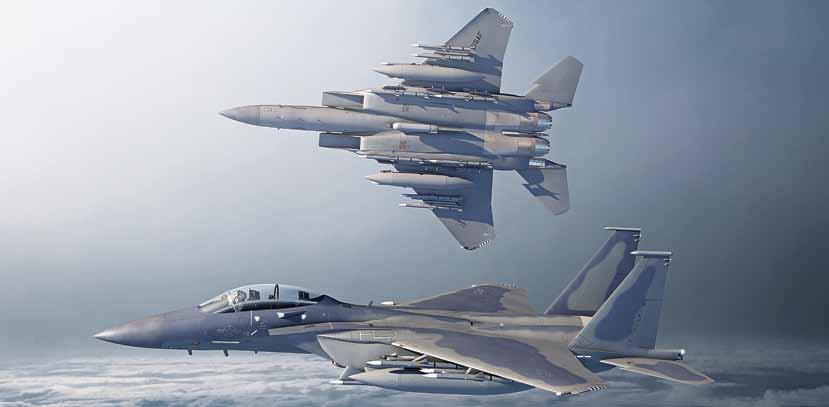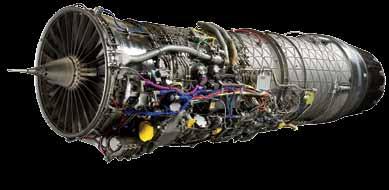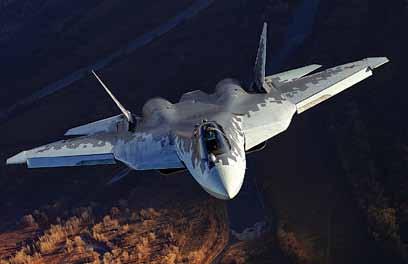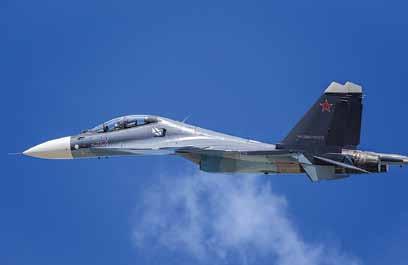
8 minute read
Fighters
F-15EX thE advancEd vErsion oF thE F-15 is PoWErEd BY F100-PW-229
F-15EX AN EVOLVING FIGHTER
Advertisement
By Air MArshAl B.K. PAndey (retd)
COMBAT AIRCRAFT FOR THE USAF
In July this year, the United States Air Force (USAF) placed an order with the US aerospace major Boeing for the first lot of the fourth generation plus F-15EX combat jets that carries a new name of Eagle II. This order that has a prescribed ceiling in its value at $23 billion, is meant to inject fresh blood to revitalise the fleet of combat aircraft of the USAF that has been operating around 235 of the F-15 C/D for several decades and are due to be retired from service in not too distant a future. The F-15EX is a two-seat combat platform with fly-by-wire controls, a substantially more powerful mission computer, new cockpit displays, a digital backbone, and the Eagle Passive Active Warning Survivability System (EPAWSS) which is an electronic warfare and threat identification system. The most significant upgrade comes in the form of an open mission systems architecture that will allow the service to update the software on the F-15EX far more easily and rapidly. As per Lori Schneider, the Programme Manager of Boeing, the F-15EX is the most advanced version of the F-15 ever built, due in large part to its digital backbone. Its unmatched range, price and best-in-class payload capacity make the F-15EX an attractive choice for the USAF. While the contract has an in-built option of the procurement of up to 200 aircraft, the USAF is currently looking at a figure of 144 at a flyaway cost of $87.7 million per aircraft.
TEcHnIcal SpEcIFIcaTIonS
Length 63.8 ft (19.45 m) Height 18.5 ft (5.65 m) Wing Span 42.8 ft (13.05 m)
Propulsion
two P&W F100 or two gE F110 turbofan engines in 29,000 lb (13,154 kg) thrust class with afterburning Weight 45,000 lb (20, 411 kg) class 81,000 lb (36, 700 kg) max gross takeoff Speed 1,875 mph (3,017 kph)
Armament
F-15A/B/C/D air-to-air: 20mm cannon aim-120 (amraam) missiles aim-9 (sidewinder) missiles aim-7 (sparrow) missiles F-15E Air-to-ground: Precision guided munitions variety of missiles and bombs F-15E Air-to-air: cannon 8 medium- and short-range missiles Advanced F-15: 12 air-to-air missiles 24 air-to-ground munitions
sourcE: www.boeing.com/defense/f-15/
EVOLUTION OF THE F-15EX
The basic F-15 platform from which the F-15EX has now evolved, is a twin-engine, all weather tactical combat aircraft designed by McDonnell Douglas that is now a part of Boeing. The first prototype of the F-15 undertook its maiden flight in July 1972 and the aircraft entered operational service in 1976. The F-15 is regarded as being among the most successful modern combat aircraft in the world with over 100 victories and no losses in aerial combat. As of 2021, several variants of this platform have been produced and operationalised. The most recent model of this platform is the F-15EX which is the most powerful, most advanced and most agile version of this platform produced till date. With the induction of the F-15EX, the USAF has practically ushered in a new era.
POWERING THE NEW PLATFORM
Prior to the first order for the F-15EX placed in July this year, on account of compelling urgency, the USAF had awarded a separate contract to General Electric for an unspecified number of F110-GE-129 engines to power the initial batch of F-15EX to be delivered against the order placed in July this year. However, as this decision would have resulted in creating a single-vendor situation which would have been undesirable for the reputation of the USAF as well as of the original equipment manufacturer (OEM) involved in the contract for the engine, there has been some reconsideration in this regard. Consequent to this development, the USAF held an open competition to select a new engine for the F-15EX. Pratt & Whitney thus got the opportunity to enter the competition with its offer of the F100-PW-229 engine as a viable alternative.
The association between Pratt & Whitney and the USAF has been a long one and can be described as a partnership as the F100 engine has powered every operational F-15 fighter jet that has served in the USAF since 1972, the year in which the F-15 fighter jet took to the skies for the first time. Since then, every consecutive variant of the F-15 powered by the F100 engine has undertaken countless number of successful combat operations around the world. Decades of association with the USAF has been of immense benefit for Pratt & Whitney as it has successfully facilitated the OEM to usher in several new engine types for the evolving variants of the F-15 over the years. The list of engines developed by Pratt & Whitney includes the F100-PW-229 engine, the latest version of the evolving F100 family that is in production today and has been offered as a good option to power the F-15EX.
ADVANTAGES OFFERED BY PRATT & WHITNEY
Selection of the F100-PW-229 engine from offered by Pratt & Whitney as against the offer by its rival GE, will provide a slew of advantages for the USAF. As the USAF already has an elaborate infrastructure at their air bases for maintenance, repair and overhaul of the F-15C/D that has been developed over the last few decades, it will require only minor increment in the existing infrastructure for the maintenance of the new fleet of F-15EX. This will help reduce substantially the quantum of investment that would be required to set up new infrastructure if an engine from a company other than Pratt & Whitney is opted for to power the newly acquired fleet of F-15EX combat jets. In addition, the maintenance equipment, training and manuals for the F100 engine powering the F-15C already exist. Only minimal changes are needed to update the F100 power plant for the F-15EX when compared to supporting an entirely new engine. It will thus make transition from the current feet of F-15C/D to the F-15EX far more seamless. One important factor that ought not to be underestimated or ignored is that with more than 28 million flight hours under its belt, the F100 fighter engine has a world class record in respect of safety, maintenance and reliability.
Another major advantage for Boeing in opting for the Pratt & Whitney engine for the F-15EX lies in the plans by the latter for further advances in engine technology. Pratt & Whitney already has the F119 engine that powers the next generation tactical stealth fighter aircraft such as the Lockheed Martin F-22 Raptor and the F135 fitted on the Lockheed Martin F-35 Lightning II, a single-engine strike fighter endowed with short takeoff and vertical landing capabilities. As the USAF is embarked on the induction of the F-15EX, Pratt & Whitney can provide the engine for this platform that will help the service in achieving enhanced operational capability. SP
F100-PW-229 EnginEFrom Pratt & WhitnEY has BEEn sElEctEd as thEEnginEFor thE F-15EX. With morE than 28 million Flight hours undEr its BElt, thE F100 FightEr EnginE has a World class rEcord in rEsPEct oF saFEtY, maintEnancE and rEliaBilitY.



(Left) Sukhoi Su-57e iS an export verSion of the ruSSia’S 5th generation muLtiroLe combat aircraft; (right) Su-30Sme iS further derivative of the Su-27/Su-30 famiLy of 4+ generation fighter aircraft
ROSOBORONEXPORT: CONTRACTS GROW STEADILY
The summer exhibition period 2021 has demonstrated strong demand for Russian weapons and military equipment. At the ARMY-2021 Military-Technical Forum, MAKS-2021 Aerospace Salon and IMDS-2021 Maritime Defence Show, Rosoboronexport (Rostec State Corporation subsidiary) held negotiations with foreign partners and signed over 30 contract documents worth over 3 billion euros.
Rosoboronexport has leveraged the full potential
of Russian summer defence exhibitions, thereby replenishing its order portfolio and increasing the workload of the domestic defence enterprises.The export plan now includes Su-30-type aircraft, Mi-35M/P, Mi-171Sh and Mi-17V-5 helicopters, aircraft weapons, Pantsir-S1/S1M self-propelled anti-aircraft gun/missile (SPAAGM) system, Verba MANPADS, Protivnik-GE radar, Krasukha electronic warfare system, Repellent-Patrol mobile anti-drone EW system, Kornet-EM ATGM system, remote controlled weapon stations, weapons for surface combatants and submarines, small arms, ammunition. An agreement was reached on integrating Russia’s Palma shipborne gun/missile close-in weapon system (CIWS) into a ship’s foreign-made weapons system.
Russia’s constant success in military-technical cooperation proves the domestic industry’s capability to develop new and unique, products and solutions, of a strong demand in the market. At the same time, an updated modernisation of the manufacturing plants and design bureaus’ premiseswith timely retrofitting and upgrading at the expense of funds received from the implementation of state defence orders and export contracts, launches the processes of positive transformation of infrastructure in regions, from household facilities to science schools, technology parks and experimental laboratories accessible to youth.
Among the latest Russian products being presented at the domestic exhibitions this summer, foreign partners paid special attention to the fifth-generation Su-57 fighter, Orion-E reconnaissance/strike UAV, Antey-4000 battlefield air defence missile system, Pantsir-S1M SPAAGM system, T-14 Armata tank, combat vehicles based on the Boomerang platform, the BMP-3 with the Berezhok combat module among the many. More than 80 per cent of Rosoboronexport’s annual deliveries belong tothe products of the Russian Engineering Union (REU) enterprises which are also Rostec’s Corporate subsidiaries, namely United Aircraft Corporation, Russian Helicopters and High-Precision Weapons Holding as well as other national leading companies.
The enterprises being associated within the REU have become a strong growth driver of the Russian economy, which greatly contributes to the development of military-technical cooperation as the high-tech products have been heavily exploited by partners from over 100 countries all over the world in the most challenging climatic and combat conditions.
Today, Rosoboronexport’s portfolio of orders exceeds $52 billion. SP










